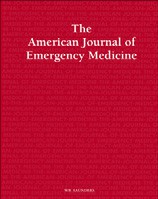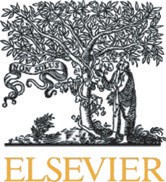Case series of exercise-induced rhabdomyolysis in the New York City jail system
Contents lists available at ScienceDirect
American Journal of Emergency Medicine
journal homepage: www. elsevier.com/ locate/ajem
Case series of exercise-induced rhabdomyolysis in the New York City jail system
To the Editor,
Rhabdomyolysis is a serious medical condition associated with skeletal muscle damage, potentially leading to renal failure and death. Causes of rhabdomyolysis include drugs, trauma, infection, exercise, heat, and toxins [1-3].
The New York City (NYC) jail system is the nation’s second largest, with approximately 12 000 inmates housed among 12 jail facilities at any time. Medical care for these inmates is the responsibility of Correctional Health Services (CHS), a bureau of the NYC Department of Health and Mental Hygiene. After discussions with patients who experienced rhabdomyolysis in the jail setting, CHS assessed the incidence of rhabdomyolysis over a 2-year period.
The electronic health record was queried for new diagnoses of rhabdomyolysis between March 1, 2011, and February 28, 2013. Cases were abstracted for key clinical variables including initial presenta- tion, laboratory results, and disposition.
In the 2-year query period, 140 888 admissions and 17 cases of rhabdomyolysis occurred in the NYC jail setting (approximate incidence 70/100 000 person-years). The average age of patients with rhabdomyolysis was 26.7 years (range, 19-40 years; Table). All patients presented to jail medical staff with history of recent Strenuous exercise and chief complaint of muscle aches; 12 of the 17 patients also mentioned urine color. Eight patients had Urine dipstick analysis done in the jail clinic, revealing proteinuria in all
8 patients and hematuria in 6 patients. Seven of the 17 patients were prescribed medications that may have exacerbated or contributed to their rhabdomyolysis including 4 patients taking mental health medications, 1 taking an antibiotic, 1 taking a protease inhibitor, and 1 taking a diuretic. All 17 patients were transferred to a nearby hospital for medical management with an average length of admission of 5.3 days (range, 1-11 days). Peak CPK values were generally between 50 000 and 400 000, although 1 patient had a peak CPK value recorded as 2000 and another as 12 000. No patients required dialysis while admitted as inpatients. Nine of the 17 pa- tients spent time in the jail infirmary after hospital discharge, with an average length of infirmary admission of 5.7 days (range, 1-14 days). No cases occurred on high heat days (outside temperature N 85?F).
All cases of rhabdomyolysis in the NYC jail system during this 2-year period appear to stem from exercise. This differs from the population at large where a multitude of factors contribute to rhabdomyolysis. We were unable to find reliable estimates of the incidence of rhabdomyolysis in the US general population. However, the rate we report here, 70 per 100 000 person-years, is in excess of the aggregate of reports we located on specific causes of rhabdomyolysis [4-6]. From the standpoint of emergency department (ED) visits, our 17 cases represent a rate of 226/100 000 ED visits, while community rates appear to be closer to 35/225 000, with exercise-induced rhabdomyolysis in the community occurring in 15.5/100 000 ED visits [7].
The striking feature of exercise as a reported causative agent for all cases of rhabdomyolysis in the jail system does reflect our clinical observations. We regularly observe that inmates performing vigorous
Rhabdomyolysis among NYC jail patients, March 1, 2011 to February 28, 2013 (n = 17)
Reported cause Exacerbating factor Presenting symptoms Peak CPK (rounded
Disposition
|
Muscle aches |
Hematuria |
Proteinuria |
to nearest 1000) |
Hospitalization (d) |
Jail infirmary (d) |
|||
|
700 squats at once |
Mental health medication |
Y |
Unk |
Unk |
N 78 000 |
4 |
4 |
|
|
500 push-ups every 2 d for 1 wk |
N |
Y |
Y |
Y |
N 78 000 |
7 |
8 |
|
|
400 squats at once |
N |
Y |
Y |
196 000 |
6 |
7 |
||
|
Many squats and push-ups at once |
Mental health medication |
Y |
Unk |
Unk |
Unk |
2 |
0 |
|
|
Strenuous exercise |
N |
Y |
Y |
125 000 |
6 |
0 |
||
|
Many sit-ups at once |
Antibiotic |
Y |
Y |
80 000 |
6 |
5 |
||
|
Many squats for 4 d |
N |
Y |
Y |
Y |
N 78 000 |
9 |
0 |
|
|
Strenuous exercise |
N |
Y |
Unk |
Y |
12 000 |
1 |
0 |
|
|
Many squats for several days |
N |
Y |
Y |
Y |
125 000 |
4 |
0 |
|
|
Hundreds of squats at once |
N |
Y |
Y |
220 000 |
7 |
14 |
||
|
500 squats daily for 4 d |
N |
Y |
Y |
Unk |
N 78 000 |
11 |
3 |
|
|
500 squats at once |
N |
Y |
Y |
Y |
63 000 |
4 |
5 |
|
|
90 min of strenuous exercise |
Mental health medication |
Y |
N |
None |
1800 |
1 |
0 |
|
|
Hundreds of squats at once |
diuretic |
Y |
N |
None |
50 000 |
4 |
0 |
|
|
400 squats at once |
Mental health medication |
Y |
N |
Unk |
401 000 |
8 |
3 |
|
|
300 squats at once |
N |
Y |
Y |
None |
77 000 |
5 |
3 |
|
|
Several hundred push-ups and |
Mental health medication |
Y |
Y |
Y |
41 000 |
6 |
0 |
|
squats at once
N, no; Y, yes; Unk, unknown.
0735-6757/$ - see front matter (C) 2014
exercise, often as part of a challenge or competition, do a specific number of squats, push-ups, and others. Similar observations were reported in an Arizona state prison, where a retrospective medical record review identified 19 cases of exercise-induced rhabdomyolysis [8]. Based on this analysis, CHS will promote awareness of this health risk of the jail environment among medical providers, so that they may have a heightened index of suspicion for rhabdomyolysis in this young population. In addition, targeted medication advising may be indicated for patients on mental health medications, diuretics, and Protease inhibitors.
Ross MacDonald, MD Zachary Rosner, MD Homer Venters, MD, MS
New York City Department of Health and Mental Hygiene
Bureau of Correctional Health Services
Queens, NY, USA E-mail address: [email protected]
http://dx.doi.org/10.1016/j.ajem.2013.08.051
Vanholder R, Sever MS, Erek E, Lameire N. Rhabdomyolysis. J Am Soc Nephrol 2000;11(8):1553-61.
Fourth-generation troponin I and infarct size in patients with ST-elevation myocardial infarction
To the Editor,
troponin I and High-sensitivity troponin T after acute myocardial infarction have proven useful for estimation of the complex and extension of coronary lesions in acute coronary syndromes, and TnI has proven useful for estimation of the infarct size in patients with a non-ST-elevation myocardial infarction [1-4].
The aim of the present study was to correlate infarct size and left ventricular function determined by echocardiography Doppler with plasma levels of TnI after ST-elevation myocardial infarction .
We studied 63 patients with STEMI. We excluded patients with non-ST-elevation myocardial infarction,
heart failure, and shock at admission in the emergency department.
We measured TnI at admission and determined the ejection fraction and number of myocardial segments affected by echocardi- ography Doppler before discharge.
There was no correlation between TnI and left ventricular function in STEMI, but there was a linear correlation with infarct size in STEMI (r = 0.71; P b .001).
We could conclude that a single measurement of TnI at admission in patients with STEMI proved useful for estimation of the infarct size but not for estimation of the left ventricular function.
Diego Conde, MD Pablo Elissamburu, MD Nicolas Lalor, MD Leandro Rodriguez, MD
Cardiology Division, Instituto Cardiovascular de Buenos
Buenos Aires, Argentina Cardiology Division, Sanatorio Anchorena
Buenos Aires, Argentina E-mail address: [email protected]
http://dx.doi.org/10.1016/j.ajem.2013.12.040
References
- Conde D, Elissamburu P, Lalor N, Rodriguez L, Trivi M. Fourth generation troponin I and complex coronary lesions in acute coronary syndromes. Am J Emerg Med 2013 (in press).
- Conde D, Costabel JP, Perdernera G, Trivi M. Relationship between high-sensitive troponin T levels in patients with acute coronary syndrome with ST elevation and complex coronary lesions. Am J Emerg Med 2013;31:1145-6.
- Conde D, Costabel JP, Campos R, Trivi M. High-sensitive troponin T levels and complex coronary lesions. Am J Emerg Med 2013;31:1141.
- Elissamburu P, Lalor N, Rodriguez L, Conde D. Fourth generation troponin I and infarct size in patients without ST elevation myocardial infarction. Am J Emerg Med. 2013 (in press).
A novel automatic staffing allocation tool based on workload and cognitive load intensity?
To the Editor,
One of the fundamental problems of emergency care is the ability to allocate resources, particularly staffing, that match patient volumes and demand [1]. Patient volumes can vary greatly by the day and/or by the hour, so planning for this complicated variability makes staffing decisions challenging for administrators and medical directors [2].
During 2011, our emergency department (ED) saw a significant but inconsistent shift in patient volume to late evenings, creating a backlog of patients that persisted into the early morning of the next day. Although there was no increase in morbidity or mortality during nightly transitions, our attending physicians felt a higher workload, related to patient volumes and complexity, created an inefficient and unsafe care environment [3].
Given the concerns from faculty, ED leadership created a small task force charged with diagnosing the problem and implementing a solution. During the first phase, this group used a Delphi methodology [4] to assess what factors created the perception of an inefficient and unsafe environment. The most important factors contributing to the problem were found to be the combination of the number of patients, mismatch with provider numbers, the complexity of disease, and the absence of a backup plan in case of a massive backlog in patients.
Several solutions were considered, including adding an additional nightly attending shift, creating casino shifts [5] (overlapping half shifts), having a regularly used surge backup physician, or requiring both attending physicians to stay until 6 AM depending on certain
? Funding sources/disclosures: Drs Boggust and Smith have commercial interest on the Mayo Clinic Yes board (ED information platform); however, the formula and the calculation described in this study, although reflected on the Yes Board display, are not part of their commercial interest.


